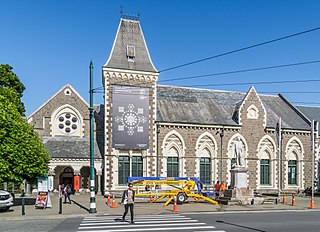
The Christchurch Botanic Gardens, located in the central city of Christchurch, New Zealand, were founded in 1863 when an English oak was planted to commemorate the solemnisation of the marriage of Prince Albert and Princess Alexandra of Denmark. The gardens sprawl over an area of 21 hectares and lie adjacent to the loop of the Avon River next to Hagley Park. The Christchurch Botanic Gardens have a variety of collections of exotic and local plants of New Zealand, several conservatories, a nursery, playground and Climatological Station.
William Hammond was a New Zealand artist who was part of the Post-colonial Gothic movement at the end of the 1990s. He lived and worked in Lyttelton, New Zealand. The theme of his works centred around the environment and social justice.

TheArts Centre Te Matatiki Toi Ora is a hub for arts, culture, education, creativity and entrepreneurship in Christchurch, New Zealand. It is located in the Gothic Revival former Canterbury College, Christchurch Boys' High School and Christchurch Girls' High School buildings, many of which were designed by Benjamin Mountfort. The centre is a national landmark and taonga as it is home to New Zealand's largest collection of category one heritage buildings with 21 of the 23 buildings covered by Heritage New Zealand listings.

The Canterbury Museum is a museum located in the central city of Christchurch, New Zealand, in the city's Cultural Precinct. The museum was established in 1867 with Julius von Haast – whose collection formed its core – as its first director. The building is registered as a "Historic Place – Category I" by Heritage New Zealand.

Auckland Art Gallery Toi o Tāmaki is the principal public gallery in Auckland, New Zealand. It has the most extensive collection of national and international art in New Zealand and frequently hosts travelling international exhibitions.
Michael Duncan Smither is a New Zealand painter and composer.

Andrew Drummond is a New Zealand painter and sculptor. He attended University of Waterloo in Canada, graduating in 1976. He was a Frances Hodgkins Fellow in 1980.

Shane William Cotton is a New Zealand painter whose work explores biculturalism, colonialism, cultural identity, Māori spirituality, and life and death.

Jeffrey Harris is a New Zealand artist. Harris started his career in Christchurch, moving to Dunedin, New Zealand in 1969. In the early 1980s he worked briefly in the United States, before moving to Melbourne, Australia in 1986. In 2000 he returned to Dunedin, where he still lives. Largely self-taught, but mentored by notable New Zealand artists such as Michael Smither and Ralph Hotere, he has painted full-time since 1970.

The Christchurch Art Gallery Te Puna o Waiwhetū, commonly known as the Christchurch Art Gallery, is the public art gallery of the city of Christchurch, New Zealand. It has its own substantial art collection and also presents a programme of New Zealand and international exhibitions. It is funded by Christchurch City Council. The gallery opened on 10 May 2003, replacing the city's previous public art gallery, the Robert McDougall Art Gallery, which had opened in 1932.

William Alexander Sutton was a New Zealand portrait and landscape artist.

Fiona Dorothy Pardington is a New Zealand artist, her principal medium being photography.

The Robert McDougall Art Gallery is a heritage building in Christchurch, New Zealand. It was designed by Edward Armstrong and it opened in 1932. It is a Category I heritage building listed with Heritage New Zealand and is located within the Christchurch Botanic Gardens.

Julia Morison is a New Zealand artist working across a wide range of media including painting, sculpture, photography, installation and recently ceramics.
Maude Burge was a New Zealand painter influenced by James Nairn. She spent time as an expatriate artist specifically in Europe. Burge was a painting companion of Frances Hodgkins who called Maude Burge a "charming changeable woman" in her published letters. They painted together at the Burge family home in St.Tropez and in Ibiza. Burge's paintings are held in the permanent collection of Auckland Art Gallery, the Museum of New Zealand Te Papa Tongarewa, the National Art Gallery of New Zealand, the Fletcher Trust Collection, the National Library of New Zealand and among private art collectors in the northern and southern hemispheres. Burge exhibited her paintings at the New Zealand Academy of Fine Arts.
Nicola Jackson is a New Zealand artist, born in Dunedin.
Susan Mary Wakefield was a New Zealand tax expert. She was also noted for her interest in art and her philanthropy, establishing Ravenscar House Museum in Christchurch with her second husband, Jim Wakefield.
Heather Straka is a New Zealand artist, based in Auckland, who primarily works with the media of painting and photography. Straka is well known as a painter that utilises a lot of detail. She often depicts cultures that are not her own, which has caused controversy at times. Her work engages with themes of economic and social upheaval in interwar China, the role of women in Arabic society and Māori in relation to colonisation in New Zealand. Eventually, the figure became important in Straka's practice and she began to use photographs as the starting point for some of her works and "Increasingly too the body feminine has become her milieu".
Miranda Parkes is a New Zealand painter and multi media artist based in Christchurch, New Zealand. Parkes' works are held in the collections of the Sarjeant Gallery and the Arts House Trust.













